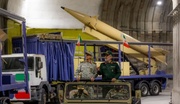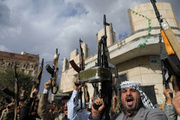The city has a history of over 3,000 years, dating back to the time of the Median Empire and a center of Zoroastrian culture. But post-Islamic era it became a religious Islamic city of Iran till present.
Yazd is a regular tourist destination for its traditional architecture; walking along the city a visitor can see traditional parts of the old Yazd remnants open for the tourists.

A very renowned traditional beauty of the city is Amir Chakhmaq Complex.

A symbol of Battle of Ashoura mourning sessions is permanantly located in front of Amir Chakhmaq Bazaar entrance that is hold to circle around the roundabout on Ashoura mourning ceremonies.

Amir Chakhmaq is in a roundabout which also includes a multi-floor building, a mosque and a religious building and a bazaar, all under the same name.

The traditional Iranian architecture employs arches in souks and entrances to bolster the structure against earthquakes and ruins by passage of time.

The traditional arch in the entrance of the bazaar. It is the common feature of traditional bazaars of Iran.

Inside the bazaar there are bakery, religious hall, some restaurants of Persian cuisine and also a store of traditional termeh – a hand-woven cloth of Iran which is woven of high-quality wool with long fibers.

Small wooden, and sometimes iron, doors welcome you to large yards surrounded by rooms on left, right and front of the entrance.


Yazd has always been a religious center in the heart of Iran, so it is all common to visit traditional religious centers neighboring the houses.


High ceilings, to keep the rooms cool, are the eye-catching phenomena when a visitor enters any indoor structure in Yazd.

Since it was a desert, all mansions and houses of ancient Yazd include wind-catchers on top to make the construction cool enough in times when there were no air conditioning system.
ZK/SH
MNA
END























Your Comment